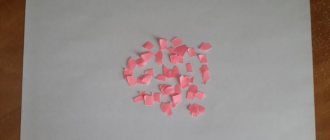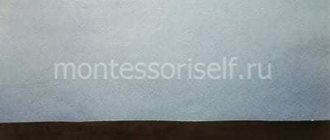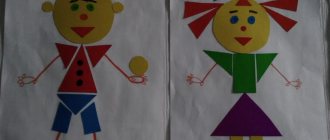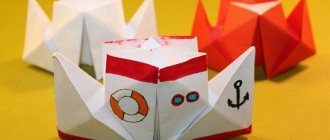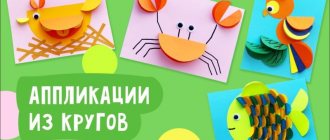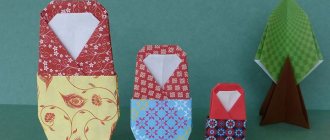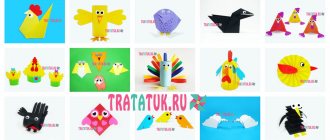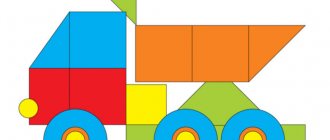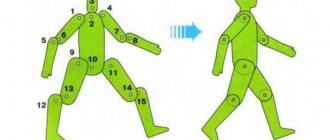Plan – summary of the lesson “Appliqué as a means of expression”, grades 2-3
Plan – summary of the lesson “Appliqué as a means of expression”
The lesson is designed for primary schoolchildren (grades 2-3), lesson duration is 40 minutes.
Goal: To promote the development of a creative, active personality, the formation of conditions for systematization of the studied material. Experience in creative activities in creating decorative compositions using appliqué technique. Objectives: Educational:
Check, generalize and consolidate students’ knowledge on the topics “Application”;
To contribute to the formation of knowledge, skills and abilities of students in creating a composition using the appliqué technique; To form the basics of modeling and designing a paper composition on a plane; Developmental:
To develop creative thinking and imagination in students;
To promote the development of cognitive interest in the fine arts. Educational: To cultivate neatness and composure, hard work, the ability to listen and hear, the ability to work in a group; Teaching methods: Reproductive methods
(Dialogue, working with information);
Productive methods
(partially search, problem-based);
Stages of the training session: 1. Emotional mood;
2. Updating knowledge; 3.Problematization; 4. Solving the problem; 5. Final reflection. Course of the training session:
1. Emotional mood. Let's remove the emotional barrier and tune in to positive work. Active Teaching Methods “Greet with your elbows” Conduct: The teacher asks the students to stand in a circle. Then he invites them to count on first-second-third and do the following: • Each “number one” puts his hands behind his head so that his elbows are pointing in different directions; • Each “number two” rests his hands on his hips so that his elbows are also directed to the right and left; • Each “number three” bends forward, puts his palms on his knees and puts his elbows out to the sides. The teacher tells the students that they are given only five minutes to complete the task. During this time, they should say hello to as many of their classmates as possible by simply saying their name and touching elbows. After five minutes, the students gather in three groups so that the first, second and third numbers are together, respectively. After this, they greet each other within their group. 2. Updating knowledge. Look at the blackboard. Answer the questions: What do you see? Is the image drawn? Do you know what this technique is called? Well done! Let's try to formulate the topic of our lesson today. (Application) What is the purpose of our lesson? What will we do and what should we get in the end? What do we need for this? What materials and tools will we need?
Task 1 Select materials and tools for appliqué. Guys, who knows what an Application is.
Task 2 Select the desired wording for the term “Applique”. There are dictionaries and books on DPI to help you. The word applique comes from the Latin “to apply” - this is a type of decorative and applied art in which details of the image of the future composition are fixed on a base taken as the background. 3.Problematization. Guys, tell me, now we know everything to start working in the applique technique? We know what applique is and what materials are needed to work with this technique. What else do you need to know? Do we know what, why and how we will make the application? Let's check?
Task 3 Number the sequence of application. • Draw a sketch of the application; • Cut out parts; • Glue the main details of the middle ground to the background; • Glue on the small foreground details. Are you confused by some incomprehensible concepts of foreground and middle ground? Let's understand it with an example.
Task 4 Write where, in your opinion, the foreground, middle and background will be located. Physical exercise. 4. Solving the problem. Since there is very little time left for the practical part, let's do it collectively. And so we have the “Clown” sketch, what do we do with it? Well done! — Cut out the details. - Transfer to colored paper. - Cut it out again. — We paste it onto the background, according to the plan.
5. Final reflection (self-assessment of actions and state)
— What happened, what difficulties did you experience during the work? -Are you satisfied with yourself? On your desks there are pieces of paper with a scale for determining mood and self-esteem. Do the work yourself. Thanks for the lesson. We are removing jobs.
We recommend watching:
Ways to increase the motivation and effectiveness of schoolchildren's learning in the process of collective and group activities. Parting words to a young specialist - choreographer About the children's art house of the village of Yaroslavskaya... Fascinating drawing lessons in elementary school
Similar articles:
Eggshell applique
Application of autumn leaves for primary schoolchildren
